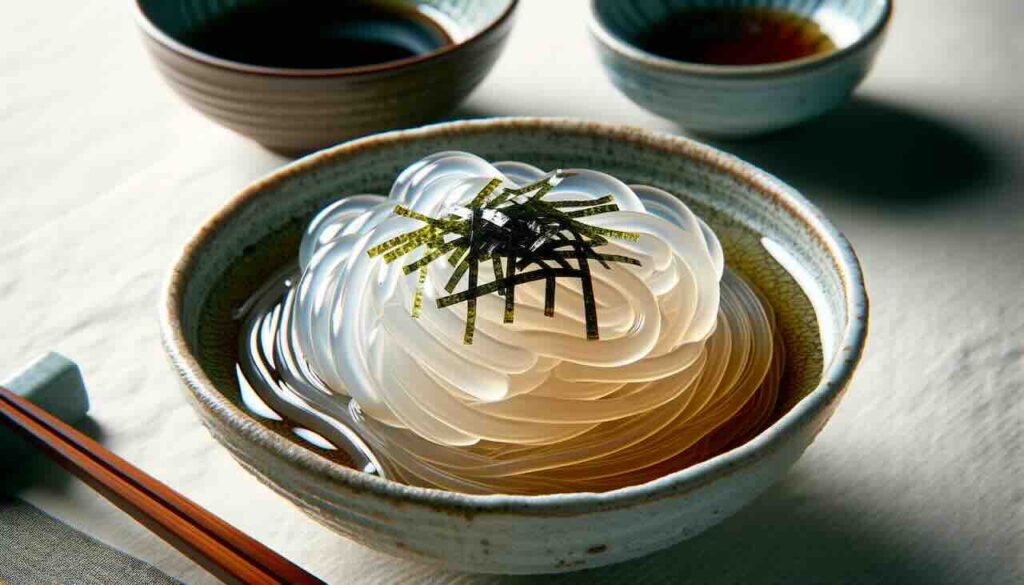When summer heat descends on Japan, few foods are as refreshing—or as uniquely Japanese—as Tokoroten (ところてん). With its slippery texture, translucent appearance, and long cultural history, this chilled jelly-like dish may seem simple at first glance. Yet behind its cool surface lies a rich story of culinary tradition, linguistic playfulness, and surprising health benefits.
What Exactly Is Tokoroten?
At its core, Tokoroten is a traditional Japanese noodle-like jelly made from tengusa (天草), a type of red seaweed. Unlike gelatin-based jellies familiar in the West, Tokoroten is entirely plant-based and has been enjoyed in Japan for over 1,000 years—its roots tracing back as far as the Nara period (8th century).
How It’s Made
- Tengusa seaweed is boiled down to extract its natural gelling properties.
- The liquid is poured into molds, cooled, and solidified.
- Once firm, the jelly is sliced into long, thin noodles using a special Tokoroten press.
- It’s typically served chilled, offering a wonderfully bouncy, slippery texture perfect for hot summer days.
Tokoroten vs. Kanten, Kuzukiri, and Western Jelly: Not All Jellies Are Equal
While Tokoroten resembles other jelly-like foods, it is distinct in both its production and culinary experience. Here’s how it compares:
Kanten (寒天)
- Also derived from tengusa seaweed.
- After boiling, kanten is dehydrated into dry blocks, allowing long-term storage.
- Rehydrated kanten yields a firmer, less moist gel compared to Tokoroten.
- Commonly used for wagashi (Japanese sweets) and vegan desserts.
Kuzukiri (葛切り)
- Made from kudzu starch dissolved in water and cooked into translucent strips.
- Softer, silkier texture than Tokoroten.
- Often served in sweet syrup as a traditional summer dessert.
Western-Style Jelly
- Made from gelatin (animal-based) or modern gelling agents like pectin.
- Flavored with fruit juice, sugar, or dairy.
- Much softer and fruitier, lacking the springy texture of Tokoroten.
- Considered a Western confection, while Tokoroten is firmly rooted in Japanese food culture.
The Curious Name: Why Is It Called “Tokoroten”?
The term “Tokoroten” carries an interesting linguistic history reflecting Japan’s love for wordplay (ateji, 当て字)—assigning kanji characters for their phonetic value rather than literal meaning.
- Tokoroten was often written using the characters 心太 (kokoro + futoi), despite no direct meaning from these characters.
- In older Japanese readings, “kokoro” (心) was occasionally read as “tokoro.”
- The character “太” (“fat” or “thick”) playfully references the plump shape of the jelly noodles.
- During the Edo period, this playful use of kanji was common for foods and objects, reflecting the whimsical side of Japanese language culture.
Thus, 心太 (Tokoroten) became both a linguistic curiosity and a visual hint at the jelly’s springy, thick noodles.
How Is Tokoroten Eaten?
One of Tokoroten’s unique charms is its remarkable versatility in flavor pairings, depending on regional preferences:
The Savory Version (Eastern Japan)
- Served with a dressing of rice vinegar, soy sauce, and mustard.
- A refreshing, light, savory appetizer or snack.
The Sweet Version (Western Japan and nostalgia-rich family recipes)
- Served with brown sugar syrup (kuromitsu) and sometimes topped with roasted soybean flour (kinako).
- Resembles a dessert, with mild sweetness complementing the jelly’s texture.
Both versions highlight the adaptability of Tokoroten to fit various seasonal meals and personal tastes.
The Health Appeal: Light, Low-Calorie, and Fiber-Rich
Tokoroten has long been prized not just for its taste but also for its nutritional benefits:
- Virtually zero fat and very low in calories.
- Rich in dietary fiber, promoting digestion and satiety.
- Completely plant-based — ideal for vegan or vegetarian diets.
- Easy on the stomach during Japan’s hot and humid summers.
For health-conscious eaters, Tokoroten provides a guilt-free way to indulge while staying cool.
Tokoroten’s Place in Japan’s Seasonal Food Culture
Tokoroten embodies the Japanese cultural principle of shun (旬)—celebrating seasonal foods at their peak:
- In summer, Tokoroten offers visual coolness, textural refreshment, and nutritional lightness, aligning with Japan’s deep appreciation for seasonal eating.
- Its long history makes it both comfortingly traditional and continuously relevant, even as modern desserts grow more elaborate.
Summary
Though humble in appearance, Tokoroten is a deeply Japanese food—blending simple ingredients, historical roots, linguistic charm, seasonal mindfulness, and health-conscious eating into one slippery, satisfying summer treat. Whether served savory or sweet, Tokoroten reflects Japan’s ability to turn minimalism into culinary artistry.
So, the next time you encounter Tokoroten on a summer trip to Japan—or even in an adventurous Japanese restaurant abroad—remember: you’re not just eating jelly. You’re tasting over a millennium of tradition, clever wordplay, and summer refreshment.


